Posts Tagged ‘snapshot on crime’
Posted on: January 16th, 2017 by Waterloo Region Crime Prevention Council
Homicide rates rose in 2015 in Canada, Ontario, and Kitchener-Cambridge-Waterloo census metropolitan area (CMA).[1] It will remain to be seen over the next few years whether this represents a notable change or simply reflhttp://ftn#1ects year-to-year variations in rates. Nonetheless, homicide rates in both Ontario and the Kitchener-Cambridge-Waterloo CMA continue to be below the national average, and Canada’s homicide rate has been dropping overall since 1975. What we do see is that homicide continues to impact some groups more than others, including Aboriginals, males, and those living in the Prairie Provinces.
The homicide rate in Canada rose in 2015 by 15%, reaching its highest levels since 2011. In 2014, there were 521 homicides, while in 2015, there were 604, increasing the homicide rate per 100,000 Canadians from 1.47 to 1.68.[2], which is still 2% lower than the average rate for the ten-year period between 2005 and 2014.[3]
Ontario also saw an increase in the homicide rate from 1.14 to 1.26. The Kitchener-Cambridge-Waterloo CMA also saw an increase in homicides from 3 to 6, with a corresponding increase in the homicide rate from 0.56 to 1.11, but these numbers are more variable because of the lower number of homicides.
Homicides in Canada, 1964-2015:
What has changed
2015 saw increases in homicide both involving firearms and involving gang violence. In Canada in 2014, 155 homicides were committed with a firearm, compared to 178 in 2015, an increase of 15%, and the highest number since 2008. Gang-related homicides also increased from 82 in 2014 to 98 in 2015, an increase of 20%, and the highest number of gang-related homicides since 2011.
The number of homicides increased primarily in three provinces: Ontario, which had 18 more homicides for a local increase of 23%; Alberta, which had 27 more homicides for a local increase of 25%; and Saskatchewan, which had 19 more homicides for an increase of 79%.
However, not all changes in homicide rates were increases.
- Homicides by strangers dropped by 21% from 73 to 58 between 2014 and 2015. Conversely, 87% of victims knew those accused of their homicides.
- Intimate-partner homicides remained relatively stable, with 83 such homicides in 2015 compared with 80 such homicides in 2014.
Continuing Patterns
Homicide continues to affect certain portions of the population and certain parts of Canada more than others.
- Homicide continues to disproportionately involve Aboriginal Canadians, with 25% of homicide victims and 33% of those accused of homicide being Aboriginal, though Aboriginals make up only 5% of the population.
Homicides among Aboriginal people in Canada:
- Males continue to be over-represented when it comes to homicide, accounting for 71% of homicide victims and 88% of those accused of homicide.
- Homicide continues to be overly prominent in the Prairie Provinces, for all of which homicide rates are now over 3 per 100,000, with Saskatchewan’s and Manitoba’s rates being more than double the national average.
Putting It All Together
Homicide provides a significant cost to Canadian society. According to a research report by Public Safety Canada, each homicide costs Canadians between $4.8 and $5.9 million.[4] These costs, along with the human costs of homicide, provide important incentives for monitoring and reducing the number of homicides in Canada.
Though homicide rates increased between 2014, it is difficult to say what this means. There have been similar spikes before, such as in 2011, when the rate spiked by 8% only to drop by over 10% the next year. Ontario witnessed a similar spike and drop between 2005 and 2006. In regard to the Kitchener-Cambridge-Waterloo CMA, because there are so few homicides, the homicide rate is likely to vary from year to year, with 8 homicides in 2013, then 3 in 2014 and 6 in 2015. It would take several years of higher rates before any continuing pattern could be identified. Nonetheless, the homicide rate in Ontario of 1.26 per 100,000 remains below the national average of 1.68, as does the homicide rate in the Kitchener-Cambridge-Waterloo CMA at 1.11 per 100,000. Overall, homicide has been on a decline since a national high of 3.02 in 1975. What we do see is that homicide continues to impact some groups and areas more than others, including Aboriginals, men, and the Prairie Provinces.
[1] The Kitchener-Cambridge-Waterloo census metropolitan is the Region of Waterloo excluding the Township of Wellesley and the Township of Wilmot
[2] Unless otherwise noted, all statistics are derived from Mulligan, L., Axford, M., and Solecki, A. (2016). Homicide in Canada: 2015. Ottawa: Statistics Canada. Retrieved on January 16, 2017 from http://www.statcan.gc.ca/pub/85-002-x/2016001/article/14668-eng.pdf.
[3] Statistics Canada. (2016). Homicide in Canada: 2015 [fact sheet]. Ottawa: Statistics Canada. Retrieved on January 25, 2017 from http://www.statcan.gc.ca/pub/11-627-m/11-627-m2016008-eng.htm.
[4] Gabor, T. (2015). Costs of Crime and Criminal Justice Responses. Public Safety Canada. Retrieved on January 16, 2017 from http://www.statcan.gc.ca/pub/85-002-x/2016001/article/14668-eng.pdf, p. 6.
Author: Daniel is an MSW student with the Waterloo Region Crime Prevention Council working on various research projects and community engagement initiatives. Daniel holds a doctorate in philosophy from the University of Toronto, where he taught for six years. He now runs a mediation and psychotherapy practice in downtown Kitchener while completing a master of social work degree at Wilfrid Laurier University.
Posted on: February 5th, 2014 by Waterloo Region Crime Prevention Council
In the first part of our follow up to the Snapshot on Crime series, we shared some themes and commonalities we found in the informative, thought-provoking responses of community residents and leaders to the report – A Snapshot in Time: The Root Causes of Crime in Waterloo Region. Each contributor reflected on local data in the report concerning one social, community or economic circumstance associated with increases or decreases in crime. We shared powerful quotes from contributors illustrating the importance of individual actions, and the need for transformative changes, like changes in attitudes, in order to address the root causes of crime. There was so much to share, we couldn’t fit them all in to one blog post. Read on….
Multiple Interconnected Roots Require Holistic Approaches
The connections between social, economic and community circumstances and crime are complex. There are often multiple circumstances that adversely impact people and communities requiring coordinated, holistic responses to the interconnected roots of crime and victimization.
For example, Jill Stoddart explains that children in care of child welfare “often come from disadvantaged families and have been subjected to maltreatment and neglect” and thus “are often at higher risk of involvement in the youth justice system, homelessness, substance abuse” and other problems.
While being young and male is associated with an increased risk of crime and victimization, Rohan Thompson from the inREACH gang prevention project says “the vast majority of youth crime is being committed by a small number of young offenders.” Further, these youth “have lived and been exposed to risks most of their young life, so participation in a gang is just the symptom of deeper more complex issues…” requiring “a holistic long term approach.”
Since “length of involvement in schooling significantly impacts participation in criminal activity,” school boards go to “great lengths” to decrease the number of residents without a high school education. David DeSantis gives examples of Catholic school board initiatives such as the “Supervised Alternative Learning programs [that] allow students to work full-time, get mental health supports, volunteer hours and accumulate credits.”
Challenging the way root causes are framed
Some writers questioned or re-framed the indicators defined as root causes in the report.
Julie Philips for example, questioned the association of higher crime rates with higher proportions of single parent headed households.
“…children and youth from fragmented households are perhaps just as likely to commit crime as lone-parent offspring. What do I mean by fragmented? A two parent family, where the parents… at the end of the day are too tired, burned out and stressed, leaving little time or energy to actively engage their children. “
Innovative responses
Waterloo Region’s reputation as a social and economic innovator was clearly demonstrated by our community’s innovative responses to root causes.
Sue Klassen tells how “restorative justice reduces fear of crime.”
“She [victim] learned that Brianna was not the monster that she had imagined her to be, but a troubled young woman who had been the past victim of rape and abuse, trying to turn her life around. Carol’s fear was transformed.”
Aaron Stauch says that although unemployment rates are improving, this “masks some concerning trends for specific segments of our workforce. Unemployment for youth, new Canadians…and older workers has remained high.” “..There are many local organizations implementing innovative ways of addressing these employment challenges.”
Moving Upstream
Many writers emphasized the critical need to focus more attention on preventing problems from occurring in the first place.
Amy Romagnoli explains that many community organizations “place great value on early child development as an up-stream approach to preventing negative child outcomes…Programs that promote and offer early learning opportunities need to be prioritized, implemented and given a chance to prove their value in the long term.”
So… where does all this leave us?
First, the good news, crime rates have been steadily falling in Waterloo Region and the Snap Shot in Time report shows Waterloo Region is committed to paying attention to the root cause of crime. “A continued diligent effort to monitor and intervene in the root causes of crime is a powerful tool for ensuring that this trend can continue into the future.”
The overall picture, as illustrated in the report, for Waterloo Region is mixed. Some statistics are positive, such as higher rates of social capital compared to Ontario or Canada. In some areas, such as the percentage of people without a high school education, we are doing about the same. Yet in other areas, like some early childhood indicators, we are falling behind. The picture is incomplete though as some key indicators, such as alcohol consumption and recreational substance use cannot be tracked due to lack of reliable data.
Community residents and leaders described the important work being done in our community to address the root causes of crime and victimization and to build a safe and healthy community for everyone. They shared their insights, stories, and calls for action. One of the important messages is that everyone can make a difference – so join us!
What more do we need to do? Considering all the good efforts already under way, are you satisfied with the work of the community or would you like to do more? Is there a particular area in which you would like to see our community put more collective and concentrated effort?
Essentially…. Where do we go from here? Speak up community, you’re great at this! And you’re great at making things happen too.
Where would you like to get started?
Posted on: February 4th, 2014 by Waterloo Region Crime Prevention Council
How do we get at the root causes of crime and prevent it from happening in the first place?
This isn’t a direct, straight answer, but, the Waterloo Region Crime Prevention Council believes part of the solution is to monitor the root causes of crime over time. Then we, as a community, can better understand and address the social, community and economic conditions associated with crime and victimization. Check out the Waterloo Region Crime Prevention Council’s report – A Snapshot in Time: The Root Causes of Crime in Waterloo Region to find out how we are doing in early childhood development, employment, community trust and other important indicators.
In the months following the report’s release, community residents, leaders and experts wrote blogs responses to share stories, insights and examples of how our community is responding to the root causes of crime outlined in the report. When we read all the fantastic community responses together like a book, we started to notice some themes and commonalities.
Individual actions matter
Many blogs responses focused on the importance of individual actions in building a safe and healthy community. Volunteering, owning a home and having a stake in a healthy neighbourhood or simple acts of noticing instead of “pretend(ing) to be an island” all make a positive difference .
Waterloo City Councillor, Karen Scian, tells a moving story of her encounter with a ‘squeegee kid’ at a red light as a way of illustrating how social capital (positive connections between people) is something we can all build and that protects against crime.
“His green eyes instantly reminded me of [my son] Peter. What if? …I…called him over…We chatted…and [I] gave him paper money. I gave him my business card. I asked him to call his mom…He thanked me again and told me that he was going to get something to eat and that he would call his mom…I had to hope.”
Higher levels of home ownership also serve as a protective factor against crime. Local realtor Keith Marshall is optimistic since “we are trending well in Kitchener-Waterloo. Crime is down. Homeownership is up. Neighbourhoods that were considered unsafe and decaying fifteen years ago are transforming into sought after and vibrant places to live.”
Calls for transformative changes to address root causes
Many contributors spoke passionately of the need for deep structural changes in our communities and systems in order to transform the social and economic conditions that contribute to crime and victimization.
In reflecting on the “deplorable” rates of violence against women and the need for a larger shelter in Waterloo Region in recent years, Mary Zilney asks:
“Why doesn’t our government create a system whereby the women and children remain in the family home and the abuser is removed? …Instead of building bigger shelters, we need to turn our minds to how we collaboratively eradicate violence against women.”
Part of the solution lies in changing attitudes and awareness
Many contributors agreed that part of the societal transformation required to address the root causes of crime and build healthy communities is changing attitudes so that all people are valued and treated with respect and understanding.
Sara Casselman writes about an innovative program to reduce incidences of sexual assault that works “with men in positions to influence male youth.” This program “encourages young men to treat women with fairness, equality and respect and to stand up and speak out on gendered violence.”
Sheri Cartwright, a community volunteer, reflects on the connection between homelessness and the increase in victimization and minor crimes among those who are without a home:
“when we provide those in need with stable housing we give the opportunity to live with dignity, reduce crime, reduce addiction and give the opportunity for better success. It is a win, win situation…We need to put as much effort into creating awareness and fundraising for this as we do when collecting food and socks.”
According to Mary MacKeigan who writes about the income of low income families and individuals:
“the root of all root causes…is the stigmatization of people living in poverty. Societal attitudes / values impact our political voting choices and influence policy decisions…. if enough of us TRULY believed that everyone was a valuable member of society, we’d have much better policies in place that reflect that belief.”
Thank you to the community contributors for sharing these insights and calls to action. There’s more to come. Tune in to the next blog for part two of The Community Weighs in on the Root Causes of Crime. We’ll review the some more themes and provide additional reflections and food for thought.
Posted on: December 31st, 2013 by Waterloo Region Crime Prevention Council
I just love this time of January when you get to take a look back at what’s been accomplished over the past year, ponder what worked well and scratch your head about what emerged that you never expected.
As we turn the page into 2014, I also love the tradition of digging into our blog to find what you, the readers, found most interesting over the last year. With over 45 blog posts in 2013, there was certainly something for everyone. We had 23 different guest bloggers contribute community responses on the root causes of crime as part of the Snapshot in Time: Root Causes of Crime in Waterloo Region. You can find all the posts and community responses in one tidy corner of the blog.
But, our readers are diverse which indicates why our most popular blogs on Smart on Crime ranged from book reviews to casinos and from guest commentary to provincial budget analysis. Here’s the round up of our top 13 posts from 2013.
1. The local impact of youth unemployment/underemployment – guest post by Carol Simpson
“If youth in the labour market cannot find employment, they find it increasingly difficult to become established in the “adult” world. They have done nothing wrong. They have done what they were told to do and were supposed to do yet cannot find that suitable connection to the workforce. This impacts their confidence and their ability to “fit in”. Many have chosen to give up and have simply walked away from the labour market making it even harder to find their “place” in the world. This results in frustration and anger and they feel neglected.”
2. What we’re reading: Rescuing Policy – by Anthony Piscitelli
“How can government solve the complex issues facing society?”
3. Children in care in Waterloo Region: Compounding risk for vulnerable children – by Jill Stoddart
“Children living in the care of the child welfare system have a higher likelihood of justice system involvement in comparison to children living with their biological parents”.
4. Excuse me Waterloo Region, your homelessness is showing – by Lynn Macaulay
“I feel part of a sector where I join in solidarity with people experiencing homelessness and many community members who together stand up to say – people who are homeless matter. We collectively are committed to ending homelessness in Waterloo Region. This is a lofty goal, which will take much persistence and hard work, but with the determination and skills of this community, I believe it is possible.”
5. Income of low income families: Root cause of crime in Waterloo Region – by Anthony Piscitelli
Neighbourhoods that are at an economic disadvantage when compared to other areas report higher crime rates. In addition, societies where wealth is concentrated amongst a small group of individuals report higher crime rates.
6. Through the eyes of crime prevention: Ontario 2013 Budget – prepared by Alexadra Kraushaar

7. The day I went to prison – by Andrew Jackson
“Five minutes later I stood at the front of a classroom with 25 women waiting for me to start talking. “Good morning” I said. “Good morning.” came the reply from the women of Grand Valley Institution for Women (GVI).”
8. Knowing other people care: The importance of community to women who have experienced homelessness – by Elizabeth Clarke
“It goes almost without saying that the overarching cause of homelessness is poverty, but not all people who are poor become homeless. Not all people who become homeless stay that way for long.”
9. Waterloo Region’s Catholic Schools: Laying a solid foundation for student success – by David DeSantis
“It is no surprise that the length of involvement in schooling significantly impacts participation in criminal activity and the probability of incarceration, as found in Snapshot in Time: Root Causes of Crime in Waterloo Region. In fact, this has been well-known in the education sector for many years – which explains the great lengths to which school boards go in mitigating against this problem.”
10. 7 things we learned from Alan Quarry about social media for social change – by Juanita Metzger
“Creating change that lasts happens in relationships, from one person to another, and these days, often facilitated with the power of social media. Here are Alan’s 7 best thoughts on the principles for engaging people in change.”
11. A Snapshot in Time: The Root Causes of Crime in Waterloo Region – by Anthony Piscitelli
“The Waterloo Region Crime Prevention Council believes monitoring the root causes of crime can aid the community in addressing crime, victimization and fear of crime through awareness, discussion, leadership and action. Once the root causes are understood more clearly, resources can be applied to areas where the community is doing poorly. A Snapshot in Time: The Root Causes of Crime in Waterloo Region identifies the root causes of crime right here in Waterloo Region and provides a tool to aid local policy makers in targeting interventions to where they are most needed and where they can have the greatest impact.”
12. Poverty in Waterloo Region… Is that REALLY OK with you? – by Mary MacKeigan
“The data in the section of Root Causes of Crime in Waterloo Region titled Income of Low Income Families is no surprise to those of us who are familiar with poverty-related issues in our regional community. In fact, in Waterloo Region, 36 earners make more than $2.57M; 360 make more than $685K; 3,610 (the top 1%) make more than $396K. Individuals who make more than $81,200 are in the top 10%. On the other hand, the median income of the bottom 50% is $14,100!* In 2007, one third of employed individuals were earning $14.00/hour or less. This is poor – it may not be deep (or absolute) poverty, but it is precariously close to it. “
13. What are the odds? The vulnerable child of today as the problem gambler of tomorrow – by Chris Sadeler
“The official position statement of the Waterloo Region Crime Prevention Council given at a public consultation on the question of a casino in the City of Kitchener. The remarks were given by WRCPC Executive Director, Christiane Sadeler on behalf of the Waterloo Region Crime Prevention Council.”
So many great reads from 2013. But if you’re in the mood for something to watch, rather than read, might I suggest our personal favourite, “Won’t you be my neighbour?” Who can resist Anthony Piscitelli’s homage to Mr. Rogers!
We look forward to bringing more great smart on crime blogs for you to ponder. Better yet, we love hearing your comments, reactions and responses to the posts and guest commentaries. We look forward to hearing more from you in 2014!
Posted on: December 4th, 2013 by Waterloo Region Crime Prevention Council
Communities with a higher proportion of lone-parent headed households are associated with higher crime rates. Children from lone parent headed households face low incomes and other significant risk factors for becoming a victim or perpetrator of crime. The chart below tracks percentage of lone parent families in Waterloo Region and Ontario. The second chart tracks two parent family median incomes and single family median incomes. The gap between the two assesses whether single-parent headed households are falling behind when compared to two parent households.
The Statistics
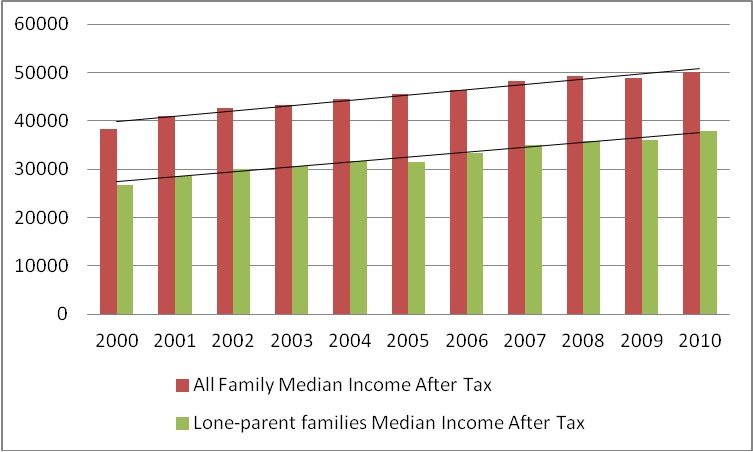
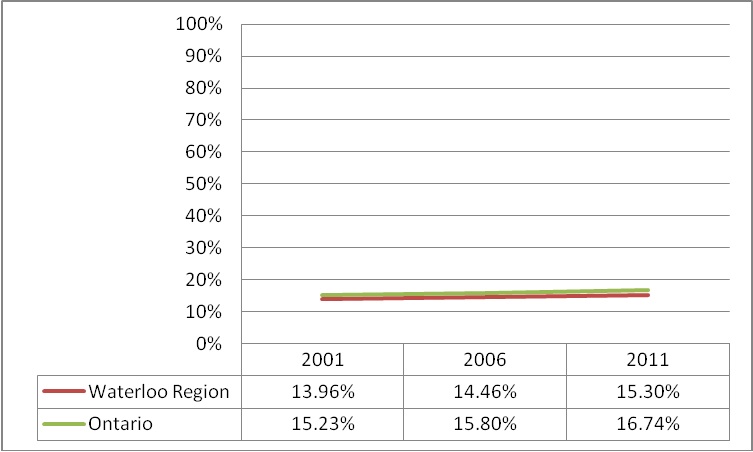 Data Sources: Statistics Canada, Census (Released Every Five Years); Statistics Canada, CANSIM Table 111-0015 (Released Annually)
Data Sources: Statistics Canada, Census (Released Every Five Years); Statistics Canada, CANSIM Table 111-0015 (Released Annually)
The Story Behind the Numbers
Waterloo Region has less single parent headed households than Ontario. However, single parent families have increased in Ontario and Waterloo Region over the past ten years. Interestingly in Waterloo Region the income of single parent headed households is growing slightly faster than two parent families in the Kitchener-Cambridge-Waterloo CMA. So while single parent headed households are growing in the region their income is keeping pace with average incomes, unfortunately they are not making any significant gains to close the gap.
Read the Community Response:
Single Parent Headed Households: A response from Big Brothers Big Sisters of Waterloo Region with Julie Philips
Posted on: December 4th, 2013 by Smart on Crime
To take a deeper look at the Single Parent Headed Households indicator in Snapshot in Time: Root Causes of Crime in Waterloo Region, we talked to Julie Philips, Chief Operating Officer for Big Brothers, Big Sisters of Waterloo Region.
1. What is your response to the data presented on this indicator/variable? How does it make you feel when you reflect on this indicator?
People often assume that children raised in a lone-parent family are more likely to live in poverty and are also more likely to commit crime. I would venture to say that children and youth from fragmented households are perhaps just as likely to commit crime as lone-parent offspring. What do I mean by fragmented? A two parent family, where the parents are too busy to invest time in their children. Parents who at the end of the day are too tired, burned out and stressed, leaving little time or energy to actively engage their children. Parents who create an unstable home life thus leaving their children to find their own sense of belonging, their network of support.
2. Who is involved in addressing this issue in your sector? What are you already doing about it?
Many organizations, both formal and informal are working to address this issue. Schools, teachers, faith communities, neighbourhood associations to social service agencies are working individually and as a collective to provide healthy networks of support for children and youth in our region regardless of family structure.
We believe in working with others to promote healthy and safe environments for children. Our programs are not “cookie-cutter or clinical” but are based on the power of friendship – having someone special to spend time with and count on. We have passion for excellence and our programs evolve with the emerging needs of our community through collaborative efforts and leveraging collective resources. Our programs are child-centered and therefore allow each child to be supported in a way that helps them reach their individual goals.
Children in our community based programs are primarily from lone-parent families or extended families.
One-to-One matches children and youth with the support of a caring adult mentor. The goal is that children and youth become empowered to reach their potential as engaged, confident and well-rounded individuals who are able to develop and maintain positive relationships.
Big Bunch provides children and youth with mentoring support through group programming. By participating in recreational opportunities, children and youth develop and maintain positive relationships, and become confident, engaged members of their community.
Children in our school based and summer programs are from a variety of family structures.
In-School Mentoring provides elementary students who could benefit from extra emotional, social or academic support, with a caring adult mentor. The goal is for students to become engaged, connected, contributing, skilled, and confident members of their school and community, empowering them to reach their potential.
Go Girls! Healthy Bodies Healthy Minds is designed for girls aged 12-14 and provides them with information to help make informed choices about healthy, active living and supports them in dealing with the emotional, social and cultural issues they may face. The goal of the program is that participants have a positive body image, high self-esteem, healthy eating habits, be physically active, and able to create and maintain healthy relationships.
Game On! uses a mentor approach to provide boys and young men with information and support to make informed choices about a range of healthy lifestyle practices. Through non-traditional physical activities, complemented with healthy eating support, participants are engaged in life skills, communication, and emotional health discussions designed to engage participants in the pursuit of life-long healthy lifestyles.
Summer Discovery supports children during the summer months. They enjoy all that summer has to offer games, crafts, activities and snacks! This day program is about having fun and building friendships, while learning and participating in physical activity together.
3. What else should be done and/or needs to be done about it?
There also needs to be greater engagement of children and youth in the process. Access to services and supports need to be simplified – it is currently too easy to get frustrated or lost in the system when trying to access support. A greater focus should be given to providing proactive rather than reactive strategies. We need to work towards removing the stigma sometimes felt by parents/families access services. The community as a whole needs to work collaborate to holistically address the needs of children and youth in the Region. This means valuing the working of the services providers and committing to sustainable revenue sources for service providers.
Thank you Julie! Thanks for your insights & responses.
 Author: Julie Phillips, a native of Cambridge, has an interest for world missions as well as local outreach. As the former Executive Director with Big Brothers Big Sisters of Cambridge she played a key role in the successful merger of the Cambridge and Kitchener-Waterloo chapters. With 12 years of experience in the non-profit sector and as Chief Operating Officer of Big Brothers Big Sisters of Waterloo Region she works towards providing youth in her community with the same opportunities she had when she was growing up. Julie is an active volunteer in her community and is passionate about the social issues affecting the well-being of our region’s residents.
Author: Julie Phillips, a native of Cambridge, has an interest for world missions as well as local outreach. As the former Executive Director with Big Brothers Big Sisters of Cambridge she played a key role in the successful merger of the Cambridge and Kitchener-Waterloo chapters. With 12 years of experience in the non-profit sector and as Chief Operating Officer of Big Brothers Big Sisters of Waterloo Region she works towards providing youth in her community with the same opportunities she had when she was growing up. Julie is an active volunteer in her community and is passionate about the social issues affecting the well-being of our region’s residents.
Posted on: November 25th, 2013 by Smart on Crime
“It is said that no one truly knows a nation until one has been inside its jails. A nation should not be judged by how it treats its highest citizens but how it treats its lowest ones” – Nelson Mandela
You have probably heard of Andrew Wiggins, Canada’s top high school basketball player. But do you know Ayodele Olutayo? Olutayo who? Is he a basket ball player or rapper? Google the name and you find nothing. So, what makes Olutayo special? Nothing really, except that he won a Rhodes Scholarship the very same week that Wiggins announced he was joining the University of Kansas men’s basketball team. Two stories. Two male black youth. Two very different media responses.
Unlike for Wiggins, the media was silent about Olutayo. Like they are about most good-news, positive stories. However, the media continues to obsess over stories that feed public appetite for fear and perpetuate western images of hyper muscular, hypersexual, anti intellectual and criminal black masculinity.
Let’s go back to Olutayo. Chosen on the basis of exceptional intellect, character, leadership and service, the Rhodes scholarship is the oldest and most prestigious scholarship in the world. Since 1904 when Rhodes Scholarships were first awarded, there have been about 1,000 Canadian who received this scholarship. Olutayo joins this elite group which includes Bob Rae, Susan Rice, and Bill Clinton, noble laureates, Pulitzer Prize winners, Olympians and scientists. However, this is not a story that aligns with the negative image of black men. Stories of negative stereotypes are given prominence in the media, feeding our collective fear and risk obsession. Positive stories are obscured as dislike of certain groups is projected as fear and we make the group one thing, and one thing only, but this risk obsession hurts us all.
Fear of fear hurts us all because it enables objectifying of others and distancing from our common humanity. Believing we have nothing in common with those who are different and unlike us, we disenfranchise them but rob ourselves of our own humanity, empathy and compassion.
Empathy is good, but what of public safety? On the other hand, risk obsession never created true safety. The zero tolerance era is prime example. Black males and aboriginal youth were excluded from education in disproportionate numbers. The fear of fear bred more fear, young lives were impacted and many were pushed out of schools into vices and criminality. There are now more aboriginal children in jails and foster homes than were in the residential schools. We may deport immigrants, confine aboriginals, jail the undesirables, but our paranoia is not assuaged. Fear of fear hurts us all, wastes public funds and renders us calloused. It’s like the TV show, Criminal Minds; the suspect who feels threatened by imagined or real fears tries to “get them before they get me”. It is sad to watch the delusions and deranged conduct on TV but harder still to see our society under the grip of fear. Waterloo Region residents are good people, it would be sad to see us sacrifice our barn raising heritage, philanthropy at the altar of risk obsession.
It is not only sad, but dangerous as it leads us to ignore real problems. No one doubts that there are real problems in society among our youth, black and white. Most serial killers and school bombers are white but we ignore them until they explode and then pundits pontificate on their mental health. But we are quick to move on to more juicy stories and tales of fear. We dissociate criminality or evil from western society so we miss warning signs. Preoccupied with fear, we stigmatize and avoid mental health issues, underfund preventive and/or redemptive programming. Most of us believe it is only a passing phase for our own youth and busy ourselves with punishing the youth we consider “the other”. Collectively, society is trapped; fear mongering, sensational media, and politically motivated, nationalist and patriotic fervor is evoked and manipulated to keep us under siege.
The fear of fear reduces our humanity and enables us to justify our inhumanity and we are thereby diminished. If we can convince ourselves that black men or Aboriginals are criminals, then compassion towards them is unwarranted. The problem is that we are no longer dealing with actual criminals; every black man becomes criminal and unworthy of compassion regardless of whether they ever commit a crime or not. The reality is that criminals come in all colours, shapes and gender but we exploit systems and structures to criminalize certain ones and then act towards that group as though they were all criminals and nothing but criminals. Harsh laws, stiffer penalties, more policing dollars, profiling, surveillance and punishing become our preoccupation. We think nothing of killing black males in “self defense” because the black male, armed or not is criminal first in our minds. Preemptive self defense and “stand your ground” laws legitimize dislike of “the other”. We all become pitiable, projecting our fears on others, we spend more on policing but crime rates decrease and we become what we obsess about.
Risk obsession excuses our inattention to preventive, rehabilitative, redemptive measures towards our youth, the oppressed, immigrants and other vulnerable populations. Society constructs black boys, not as children, but as monsters, to be feared. Many black youth in this community are upstanding students at Conestoga college, Wilfrid Laurier University, University of Waterloo or our primary and secondary schools, but when we see them downtown at night, we see only black and immediately get into flight or fight mode, becoming hyper vigilant and projecting our fears.
The African Canadian Association of Waterloo Region & Area believes that the African male child is a child, a precious gift. Some of them are children in adult bodies, confused, fearful and self conscious. We the adults in their lives must not fail them simply because we fear and are obsessed with risk. The association’s activities are designed to respect, protect, educate, empower and nurture precious seed. Through our community gardens, homework club, culture camp, and “Bring on the sunshine” event we engage our children and youth. It takes a village to raise a child and all of Waterloo Region should be the village around all of our children.
This past summer six youth interns worked with our community gardens project, digging, planting, harvesting. There was nothing to fear about them. In our homework club we actually believe kids have brains and guess what we find; they do! Who knows if tomorrow’s Rhodes Scholar lives among us. During our 2013 summer culture camp, the camp meant for young children became a hangout for many tweens and teenagers. The coordinator quickly harnessed their strengths by forming them into a volunteer corp that helped to run the camp.
Strength, beauty, faith, hope and love abound in this community. It is who we are and I am a proud and happy resident of Waterloo Region who values our beautiful mosaic. We must eschew the fears that divide, maim and paralyze us by embracing our common humanity for we are better together and shall not let fear divide us. I hope adults, youth, community leaders, academics, the criminal justice system, schools, politicians, leaders and police services will collaborate to create humane responses that benefit all and elevate all.
“The scholarship of engagement means connecting the rich resources …….. to our most pressing social, civic and ethical problems, to our children, to our schools, to our teachers and to our cities… (Ernest L. Boyer, The Scholarship of Engagement, 1996.)
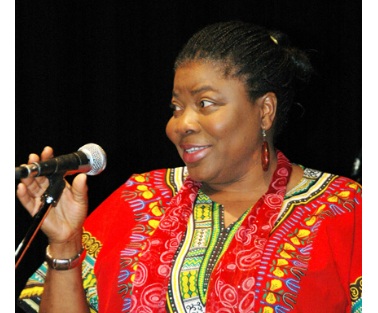
Funke Oba
Author: Funke Oba is the immediate past president of the African Canadian Association of Waterloo Region & Area. Funke teaches social work, is a diversity trainer/consultant and community based researcher with a focus on social justice, equity and social construction of complex phenomena.
Find more community responses about fear of crime:
Posted on: November 21st, 2013 by Smart on Crime
A woman’s purse is snatched as she walks downtown. A youth is swarmed and attacked by four other youth. A man pounds on his neighbour’s door, uttering threats when she refused to return his son’s football. The woman fears leaving her home. Fear of crime can skyrocket for such victims of crime. Trouble concentrating, hyper-vigilance, and a generalized feeling of being unsafe may ensue. Crime victims may install alarm systems, seek Peace Bonds, or relocate, but an increased fear of crime may persist. Friends and family, hearing about the crime, may also fear crime more.
Restorative justice can dramatically reduce crime victims’ post-traumatic stress symptoms and fear of crime. Restorative justice is a voluntary process that brings together the victim, perpetrator, and their supporters with trained facilitators to talk about how they have been affected by the crime, and who needs to do what to make things as right as possible. Community Justice Initiatives (CJI) in Kitchener has been a leader in this worldwide movement for nearly 40 years.
Carol, who was hit over the head with a broken bottle as her purse was snatched, had missed many days at work, overwhelmed by fear. In the seven months since the incident, she had been unable to face buying a new purse. When Carol and her daughter met with the perpetrator, Brianna, and Brianna’s grandmother in a facilitated process, Carol and her daughter described the far-reaching effects of the incident. Carol learned about Brianna’s traumatic history and ensuing drug habit that led to the robbery. She saw how upset Brianna’s grandmother was by Brianna’s behavior, and Brianna’s repentance and efforts to get on the right track. She learned Brianna was not the monster that she had imagined her to be, but a troubled young woman who had been the past victim of rape and abuse, trying to turn her life around. Carol’s fear was transformed. On the way home from the restorative justice process, she bought a new purse and returned the next day to work with confidence.
Vigit, who had been swarmed and hit by four other youths, no longer needed to look around anxiously as he left the house after he participated in a restorative justice process. In a follow-up interview, Vigit said, “It was great to get together with the individuals to discuss what happened. I was personally attacked and felt really unsafe at the time. This gave me peace of mind, and helped everyone move on.”
Similarly, Barbara, who was living in fear following threats Bill shouted while pounding on her door, experienced not only a renewed sense of safety, but deep compassion and support from her neighbours, who learned, as an outcome of the process, that her husband was dying of cancer. The football had come into her yard one too many times, and had damaged a birdbath made by her husband. Bill not only apologized for his threatening behavior and for bad-mouthing her character to all the neighbours. He volunteered to go around to all the neighbours and explain what had happened. The neighbours also came up with a new place for the youth to play football.
Research shows that burglary and robbery victims who go through a restorative justice process have a dramatic reduction in post-traumatic stress symptoms compared to those who don’t. Fear of crime drops not only for the direct victim, but for family, friends and neighbours, too, as they see the person responsible for the harm held accountable, apologize and take steps to repair the harm.
Just as a restorative justice process for cases before the courts can reduce fear of crime, use of restorative justice in schools can help to build a stronger sense of safety and community. Schools that use restorative justice to address crime and harm have lower suspension rates and higher perceptions of safety by staff and students. This typically leads to a more effective learning environment, less absenteeism of staff and students, and higher student achievement levels.
Restorative justice can also be used within the community to help people resolve escalating tensions between neighbours, on sports teams, or within housing developments. After meeting with trained mediators and addressing the underlying issues behind people’s positions, the fear of violence erupting is replaced with new understanding and a mutually acceptable way forward.
Contact Community Justice Initiatives for more information about restorative justice, or to explore using a restorative justice process to address a particular crime, harm or conflict. Be part of the movement to build healthier communities and reduce the fear of crime.
Community Justice Initiatives
49 Queen St. N—3rd floor
Kitchener, Ontario N2H 2G9
info@cjiwr.com | 519-744-6549
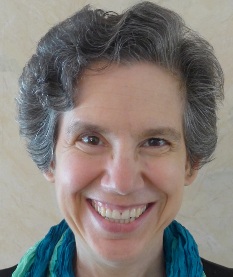 Author: Sue Klassen is completing her Masters in Conflict Transformation, with concentrations in Restorative Justice and Trauma Healing. As past president of Partners in Restorative Initiatives, a restorative justice agency in Rochester, NY, she has 12 years experience in working with restorative justice and trauma in courts, schools and the community, as a facilitator, trainer and advocate.
Author: Sue Klassen is completing her Masters in Conflict Transformation, with concentrations in Restorative Justice and Trauma Healing. As past president of Partners in Restorative Initiatives, a restorative justice agency in Rochester, NY, she has 12 years experience in working with restorative justice and trauma in courts, schools and the community, as a facilitator, trainer and advocate.
Find more responses about fear of crime:
Posted on: November 19th, 2013 by Waterloo Region Crime Prevention Council
Fear of crime may cause an increase in crime within a community. Although there is not a consensus in the literature around this point, it is clear that fear of crime is unwelcome and tends to negatively impact quality of life. Fear of crime is measured in this survey as the percentage of respondents indicating they feel very unsafe, or somewhat unsafe, walking alone in their area after dark.
The Statistics
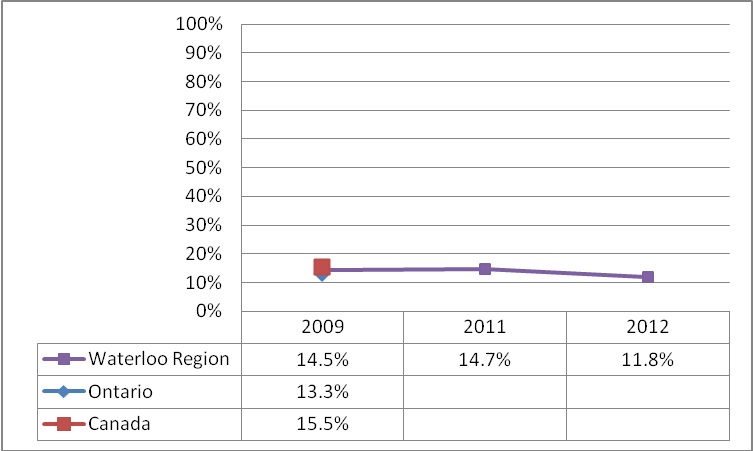 Data Sources: Statistics Canada General Social Survey Victimization Cycle (Released Every Five Years) University of Waterloo Survey Research Centre Local Area Survey (Released Annually)
Data Sources: Statistics Canada General Social Survey Victimization Cycle (Released Every Five Years) University of Waterloo Survey Research Centre Local Area Survey (Released Annually)
The Story Behind the Numbers
Levels of fear of crime in a community are expected to be relatively stable in the short term. Locally, levels of fear of crime are stable with changes within the margin of error. Comparing Waterloo Region to Ontario and Canada, the numbers are relatively similar with Waterloo Region appearing to have a slightly lower fear of crime than Canada.
Read the Community Responses:
Posted on: November 12th, 2013 by Waterloo Region Crime Prevention Council
Social capital refers to the human connections and capacities that contribute to the wealth and well being of a community. Social capital is developed in many ways such as participating in community groups, helping someone solve a problem or by saying hello to a neighbour. High levels of social capital have been linked to reduced violence in neighbourhoods. A community characterized by strong interpersonal connections helps to reduce crime by making it more likely that people in the community will watch over the neighbourhood. A simple and widely accepted measure of social capital asks the question, ‘Generally speaking, would you say that most people can be trusted or that you cannot be too careful in dealing with people?’
The Statistics
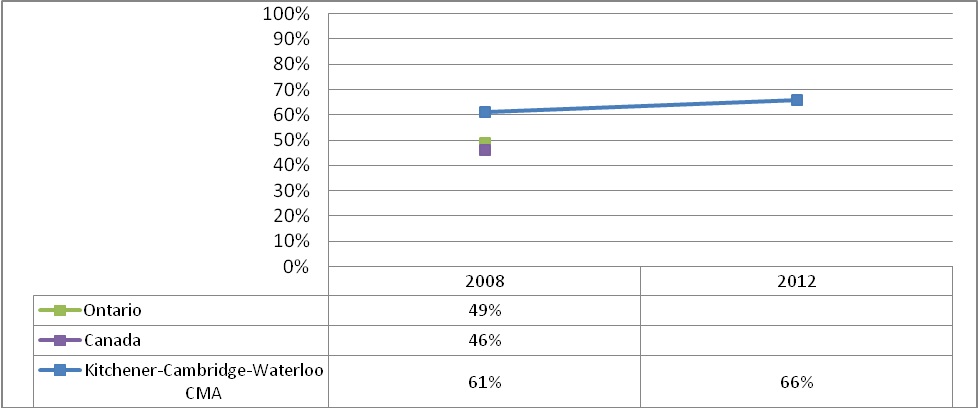
Data Sources: Statistics Canada, General Social Survey Time Use Cycle (Released Every Five Years); University of Waterloo Survey Research Centre, Local Area Survey (Released Annually)
The Story Behind the Numbers
Social trust is slightly higher in Ontario than it is in Canada and it is significantly higher in the Kitchener-Cambridge-Waterloo Census Metropolitan Area (CMA). Similar results were found on a second question in the 2008 General Social Survey, asking how much respondents trust people in their neighbourhood. The results bode well for Waterloo Region and present an important protective factor for the community. The increase in social capital between 2008 and 2012 is within the margin of error, indicating that social capital in the region is stable. Social capital does not form by itself. It tends to be the outcome of strategic and focused efforts on behalf of local institutions including the grass roots and local government to ensure an informed and engaged citizenry.
Read the Community Responses:
Life at 17 by Karen Scian, Waterloo City Councillor, Conestoga College instructor, Waterloo Public Library Trustee, Chair of the Board for Community Justice Initiatives
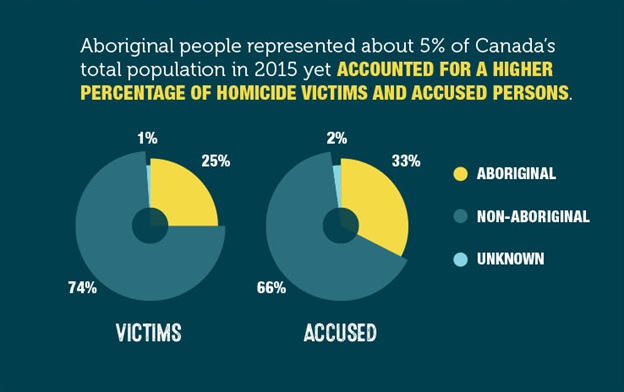

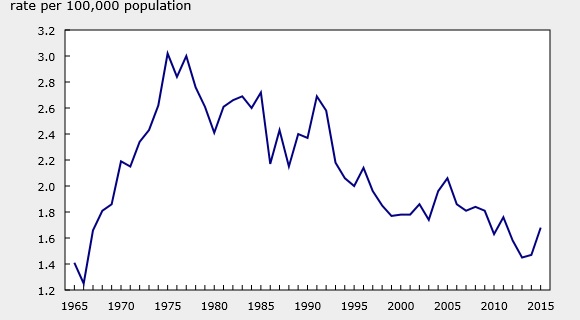


 Data Sources: Statistics Canada, Census (Released Every Five Years); Statistics Canada, CANSIM Table 111-0015 (Released Annually)
Data Sources: Statistics Canada, Census (Released Every Five Years); Statistics Canada, CANSIM Table 111-0015 (Released Annually) Author: Julie Phillips, a native of Cambridge, has an interest for world missions as well as local outreach. As the former Executive Director with Big Brothers Big Sisters of Cambridge she played a key role in the successful merger of the Cambridge and Kitchener-Waterloo chapters. With 12 years of experience in the non-profit sector and as Chief Operating Officer of
Author: Julie Phillips, a native of Cambridge, has an interest for world missions as well as local outreach. As the former Executive Director with Big Brothers Big Sisters of Cambridge she played a key role in the successful merger of the Cambridge and Kitchener-Waterloo chapters. With 12 years of experience in the non-profit sector and as Chief Operating Officer of
 Author: Sue Klassen is completing her Masters in Conflict Transformation, with concentrations in Restorative Justice and Trauma Healing. As past president of Partners in Restorative Initiatives, a restorative justice agency in Rochester, NY, she has 12 years experience in working with restorative justice and trauma in courts, schools and the community, as a facilitator, trainer and advocate.
Author: Sue Klassen is completing her Masters in Conflict Transformation, with concentrations in Restorative Justice and Trauma Healing. As past president of Partners in Restorative Initiatives, a restorative justice agency in Rochester, NY, she has 12 years experience in working with restorative justice and trauma in courts, schools and the community, as a facilitator, trainer and advocate. Data Sources: Statistics Canada General Social Survey Victimization Cycle (Released Every Five Years) University of Waterloo Survey Research Centre Local Area Survey (Released Annually)
Data Sources: Statistics Canada General Social Survey Victimization Cycle (Released Every Five Years) University of Waterloo Survey Research Centre Local Area Survey (Released Annually)